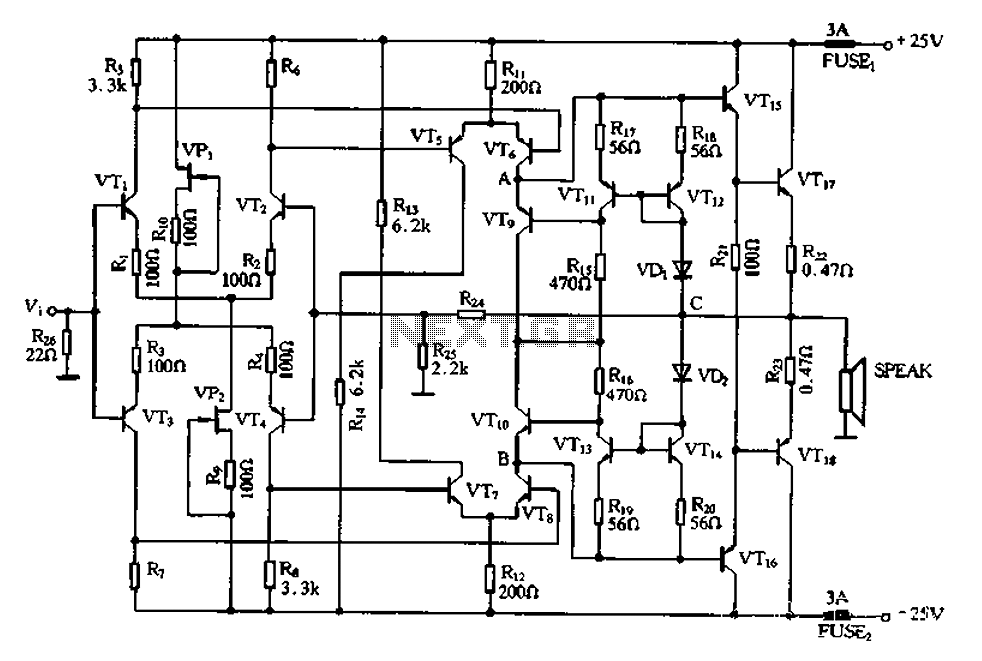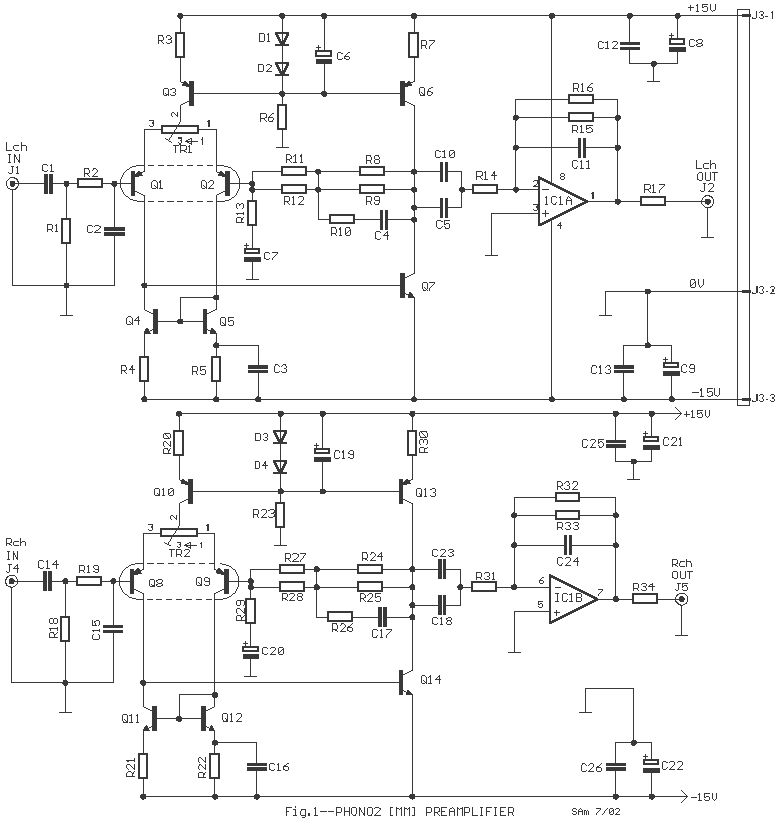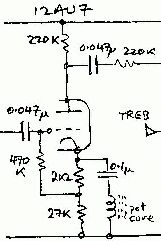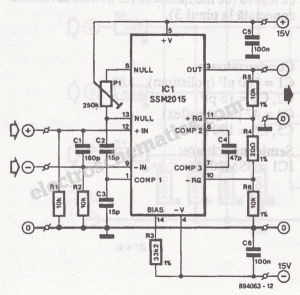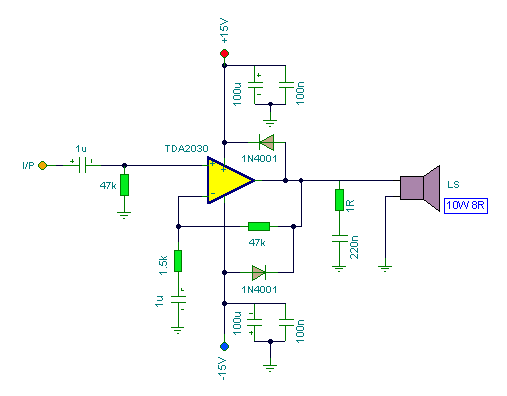
LM3886 Amplifier Gainclone
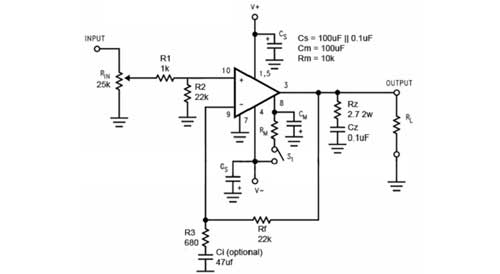
Several years ago, National Semiconductor developed high-performance, user-friendly audio power amplifier circuits known as the LM3886. An additional amplifier was required to bi-amp homemade electrostatic speakers, prompting the selection of the LM3886 chip due to its ease of use, exceptional performance, low distortion, and built-in protection against short circuits and thermal instability. The process of integrating a power amplifier is relatively straightforward. However, when driving electrostatic speakers, adequate protection is crucial. There are individuals with "golden ears" who believe that no application note schematic is sufficient for optimal performance and often propose modifications. Unfortunately, many of these individuals lack engineering expertise and do not fully understand the potential consequences of their suggested enhancements. For instance, during a period when these chips gained popularity among audiophiles, there was a trend advocating for minimal power filter capacitors for the "best sound." Specifically, recommendations included using only 500 µF on each power rail for each LM3886 amplifier chip. This configuration is clearly inadequate and results in distortion at low volumes due to power supply sagging under load. Some audiophiles misinterpreted the power supply rejection specifications of the IC, mistakenly believing that the chip could tolerate a 10V power supply ripple. Recently, the trend has shifted, and many music enthusiasts now advocate for significantly increased energy storage in the power supply.
The LM3886 audio power amplifier is a robust integrated circuit designed to deliver high-quality audio output with minimal distortion. It features a maximum output power of 68 watts into an 8-ohm load, making it suitable for driving a variety of speaker types, including electrostatic speakers that require precise and clean amplification. The chip operates within a voltage range of 10V to 30V, allowing for flexibility in power supply design.
The internal architecture of the LM3886 includes a thermal shutdown feature and short-circuit protection, which enhances reliability during operation. These protective measures are crucial when working with sensitive electrostatic speakers that can be easily damaged by excessive power or thermal stress.
In terms of power supply design, it is essential to use adequate filter capacitors to ensure stable operation. While some audiophiles may advocate for minimal capacitance, a more practical approach involves using larger capacitors—typically in the range of 2200 µF to 4700 µF on each power rail—to provide sufficient energy storage. This ensures that the amplifier can handle dynamic audio signals without experiencing voltage sag, which can lead to audible distortion.
The layout of the circuit board should also be carefully considered to minimize noise and interference. Short, direct traces should be used for power connections, and ground planes should be implemented to reduce ground loops. Additionally, employing bypass capacitors close to the power pins of the LM3886 can further enhance performance by filtering high-frequency noise.
In conclusion, the LM3886 audio power amplifier represents a reliable and high-performance solution for audio amplification needs, particularly when used with electrostatic speakers. By adhering to best practices in power supply design and circuit layout, optimal performance can be achieved while maintaining the integrity of the audio signal.Several years ago, National Semiconductor came up with some very high performance, easy to use audio power amplifier LM3886 circuits. I needed an extra amp so I can bi-amp some of my homemade electrostatic speakers so I tried the LM3886 chip.
LM3886 amplifier was chosen because of ease of use, performance, low distortion and a built-in protection against short circuits and thermal instability. There is not much to remove a power amp, than asking. When driving electrostatic speakers, you can not be much protection. There are people who have ?golden ears? and the feeling, provided that no application note scheme is never good enough for it to ?Optimize? to ?improvements? to make a claim. The problem is that most of them do not engineers and have no idea what the possible consequences of their ?improvements?
can be. For example, for a few years if these chips were popular with the audiophile crowd, it was all the rage at minimum power filter caps for ?Best Sound? to use. We are talking about 500 uF on each power rail for each chip used LM3886 amplifier. This is clearly insufficient and leads to a distortion in the volume low enough that the power supply sags under load.
The problem was that some of the golden ears of the large power supply rejection IC spec saw and thought it meant that the chip could tolerate the 10V power supply ripple. The pendulum has swung the other way, and now many music lovers are sufficient amounts of energy storage in the diet.
🔗 External reference
The LM3886 audio power amplifier is a robust integrated circuit designed to deliver high-quality audio output with minimal distortion. It features a maximum output power of 68 watts into an 8-ohm load, making it suitable for driving a variety of speaker types, including electrostatic speakers that require precise and clean amplification. The chip operates within a voltage range of 10V to 30V, allowing for flexibility in power supply design.
The internal architecture of the LM3886 includes a thermal shutdown feature and short-circuit protection, which enhances reliability during operation. These protective measures are crucial when working with sensitive electrostatic speakers that can be easily damaged by excessive power or thermal stress.
In terms of power supply design, it is essential to use adequate filter capacitors to ensure stable operation. While some audiophiles may advocate for minimal capacitance, a more practical approach involves using larger capacitors—typically in the range of 2200 µF to 4700 µF on each power rail—to provide sufficient energy storage. This ensures that the amplifier can handle dynamic audio signals without experiencing voltage sag, which can lead to audible distortion.
The layout of the circuit board should also be carefully considered to minimize noise and interference. Short, direct traces should be used for power connections, and ground planes should be implemented to reduce ground loops. Additionally, employing bypass capacitors close to the power pins of the LM3886 can further enhance performance by filtering high-frequency noise.
In conclusion, the LM3886 audio power amplifier represents a reliable and high-performance solution for audio amplification needs, particularly when used with electrostatic speakers. By adhering to best practices in power supply design and circuit layout, optimal performance can be achieved while maintaining the integrity of the audio signal.Several years ago, National Semiconductor came up with some very high performance, easy to use audio power amplifier LM3886 circuits. I needed an extra amp so I can bi-amp some of my homemade electrostatic speakers so I tried the LM3886 chip.
LM3886 amplifier was chosen because of ease of use, performance, low distortion and a built-in protection against short circuits and thermal instability. There is not much to remove a power amp, than asking. When driving electrostatic speakers, you can not be much protection. There are people who have ?golden ears? and the feeling, provided that no application note scheme is never good enough for it to ?Optimize? to ?improvements? to make a claim. The problem is that most of them do not engineers and have no idea what the possible consequences of their ?improvements?
can be. For example, for a few years if these chips were popular with the audiophile crowd, it was all the rage at minimum power filter caps for ?Best Sound? to use. We are talking about 500 uF on each power rail for each chip used LM3886 amplifier. This is clearly insufficient and leads to a distortion in the volume low enough that the power supply sags under load.
The problem was that some of the golden ears of the large power supply rejection IC spec saw and thought it meant that the chip could tolerate the 10V power supply ripple. The pendulum has swung the other way, and now many music lovers are sufficient amounts of energy storage in the diet.
🔗 External reference

